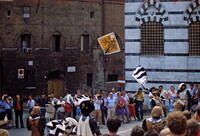Palio di Siena, August 15-16, 1984 (Cultural Documentation)
Gilchrist, Scott

Download1A2-I-S-P-A2_cp.jpg (600.9Kb)
Date
2013-02-22Description
Flag throwing in front of the Duomo; The Palio di Siena (known locally simply as the Palio), is a horse race held twice each year on July 2 and August 16 in Siena, in which the horse and rider represent one of the seventeen Contrade, or city wards. A magnificent pageant precedes the race, which attracts visitors and spectators from around the world. Both horse and rider are dressed in the colours and arms of the Contrade: Aquila (Eagle), Bruco (Caterpillar), Chiocciola (Snail), Civetta (Owl), Drago (Dragon), Giraffa (Giraffe), Istrice (Porcupine), Leocorno (Unicorn), Lupa (She-Wolf), Nicchio (Shell), Oca (Goose), Onda (Wave), Pantera (Panther), Selva (Forest), Tartuca (Tortoise), Torre (Tower) and Valdimontone (Ram). Any connection with the sacred games of the ancient Romans being obscured by time, the earliest known antecedents of the race are medieval. The town's central piazza was the site of public games, largely combative: pugna, a sort of many-sided boxing match or brawl; jousting; and in the 16th century, bullfights. Public races organized by the Contrade were popular from the 14th century on; called palii alla lunga, they were run across the whole city. When the Grand Duke of Tuscany outlawed bullfighting in 1590, the Contrade took to organising races in the Piazza del Campo. The first such races were on buffalo-back and called bufalate; asinate, races on donkey-back, later took their place, while horse-racing continued elsewhere. The first modern Palio (called palio alla tonda to distinguish it from the earlier palii alla lunga) took place around 1650. At first, one race was held each year, on July 2; a second, on August 16, was added later. Source: Wikipedia; http://en.wikipedia.org/wiki/Main_Page (accessed 7/17/2008)
Type of Work
photographSubject
domestic life, genre, historical, recreation and games, festivals, racing, pageant, Twentieth century
Rights
Rights Statement
Licensed for educational and research use by the MIT community only